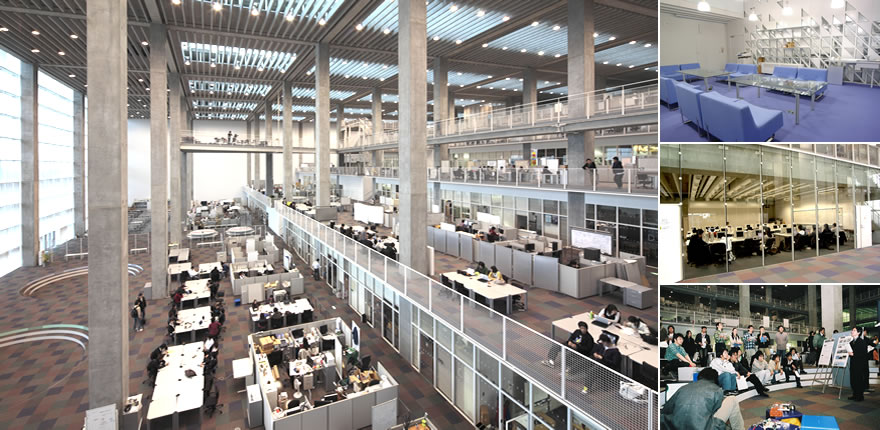
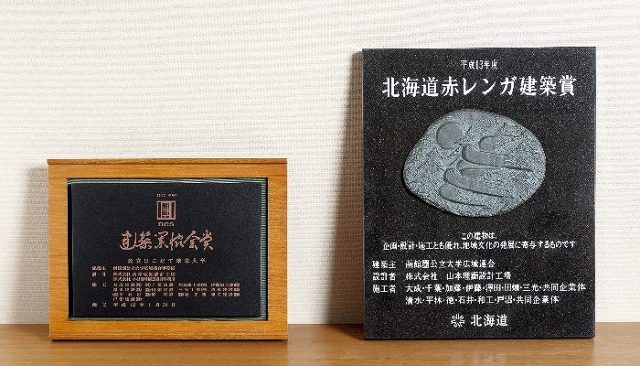
Future University Hakodate was founded in 2000 to provide a unique futuristic education and research environment that could contribute to a 21st century world with flourishing scientific technology, art and culture.
The spirit of “Open space, open mind” is the philosophy behind this enterprising spirit. The vast “Open space” of the main building allows students and teachers to connect and interact openly and be actively involved in the realization of their goals with “Open minds”.
This is the fundamental principle underlying the vitality and energy of our University, and which promotes a dynamic learning environment.

Future University (FUN) Hakodate as a Learning Organization
Traditional Universities and the Knowledge Acquisition Model
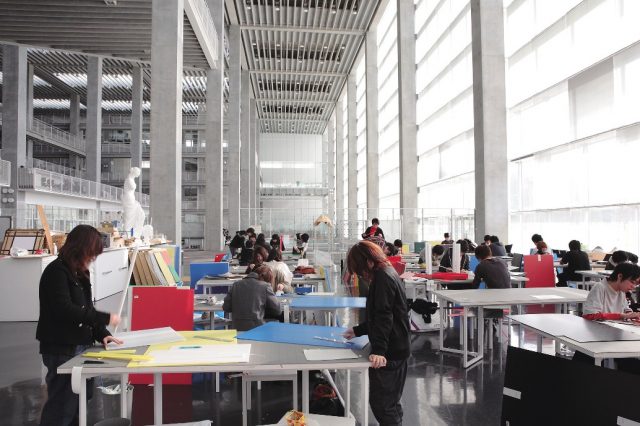 The traditional components of a university have been faculty, students, and general supporting staff. For generations, classroom instructors have stood in front of the blackboard, using standard style textbooks, and lecturing to their students. In this environment, intellectual work is thought to be an act of knowledge transfer. The human mind is seen as a container and learning is a seen as the pouring of knowledge into it and saving it. With this view of knowledge acquisition, studying is considered as individual work. On the whole, teachers give importance only to the process of acquiring and saving information, and doing this effectively was the goal of education. Over the years, this has developed into the traditional style of university education in Japan. It is not only the conservative nature of humans in general that makes traditions hard to change, but the accompanying institutions and other cultural support that grow up around such traditions. For example, the tests that students need to take to enter universities in Japan support this view of learning as “gathering up information.” All teachers in pre-college institutions from elementary school to high school feel pressure to prepare their students for this kind of exam. Furthermore, after university, in the usual exams given to enter graduate school or companies, or even the National Bar Exam or the hundred of other exams given to grant licenses for certificates (various teachers’ licenses for example) students’ ability to perform successfully is evaluated by the information and memories stored inside their heads. But of course we know that in our real lives, whether as students, workers, parents, friends, we don’t only depend on the remembered information we carry with us. In our daily lives, we solve problems not only with our personal pre-attained knowledge but more often with knowledge constructed through interacting with new situations and people. When we meet a new problem, we try to solve it by collecting information in various ways, such as consulting with others, doing research in some printed material or on the internet, or using tools or toys of some kind. Also, we need to recognize that solving problems is not just a means to gain knowledge.
The traditional components of a university have been faculty, students, and general supporting staff. For generations, classroom instructors have stood in front of the blackboard, using standard style textbooks, and lecturing to their students. In this environment, intellectual work is thought to be an act of knowledge transfer. The human mind is seen as a container and learning is a seen as the pouring of knowledge into it and saving it. With this view of knowledge acquisition, studying is considered as individual work. On the whole, teachers give importance only to the process of acquiring and saving information, and doing this effectively was the goal of education. Over the years, this has developed into the traditional style of university education in Japan. It is not only the conservative nature of humans in general that makes traditions hard to change, but the accompanying institutions and other cultural support that grow up around such traditions. For example, the tests that students need to take to enter universities in Japan support this view of learning as “gathering up information.” All teachers in pre-college institutions from elementary school to high school feel pressure to prepare their students for this kind of exam. Furthermore, after university, in the usual exams given to enter graduate school or companies, or even the National Bar Exam or the hundred of other exams given to grant licenses for certificates (various teachers’ licenses for example) students’ ability to perform successfully is evaluated by the information and memories stored inside their heads. But of course we know that in our real lives, whether as students, workers, parents, friends, we don’t only depend on the remembered information we carry with us. In our daily lives, we solve problems not only with our personal pre-attained knowledge but more often with knowledge constructed through interacting with new situations and people. When we meet a new problem, we try to solve it by collecting information in various ways, such as consulting with others, doing research in some printed material or on the internet, or using tools or toys of some kind. Also, we need to recognize that solving problems is not just a means to gain knowledge.
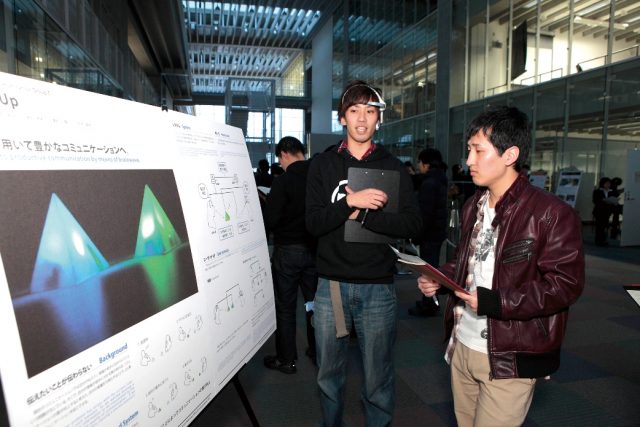 Human study is not “knowledge acquisition” so much as it is an interpersonal activity which takes place in conversation and in communication is inseparable from situations or the context. Learning should be defined as the process of interaction which occurs in social relationships within a community containing a multitude of things beyond any single individual.
Human study is not “knowledge acquisition” so much as it is an interpersonal activity which takes place in conversation and in communication is inseparable from situations or the context. Learning should be defined as the process of interaction which occurs in social relationships within a community containing a multitude of things beyond any single individual.
Designing Our New University
First Design Principle: Learning without Walls in Open Spaces
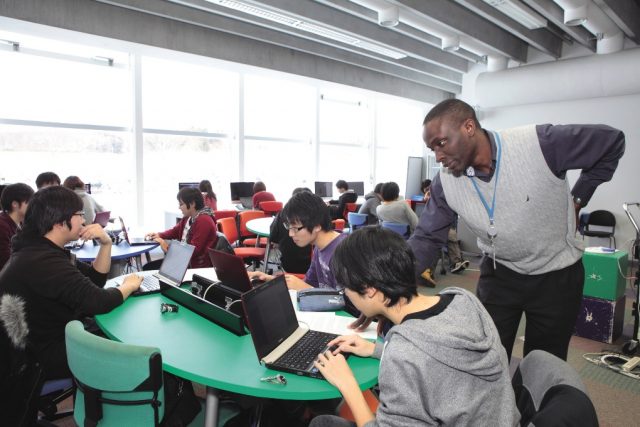 There are a lot of boundaries in traditional university education. In Future University Hakodate, we have designed a new learning environment which values learning without walls and attempts to remove various partitions – between classrooms, subjects, and learners. Faculty have traditionally stood on a raised surface, “delivering” lectures to students, who were expected to listen passively. Taking away these platforms and having completely open teaching areas or ones with glass used to limit noise but not the exchange of ideas, is our way of creating open style environments which will make interaction among students and between teachers and students very natural. With these open spaces, students or teachers walking by an interesting class or workshop might think, “Hey! What’s going on in there?” Or “Wow! That looks interesting. I’ll just walk in and join them.” Such an open atmosphere would be unthinkable in most universities in Japan where both psychological and physical doors are kept tightly shut. At FUN@Hakodate, we also intend to have a lot of teamwork. Or perhaps the concept of “teamplay” may fit our spirit better. In any case, team teaching and team learning will be rife! Our students will be actively involved with designing learning environments which will be playfully serious, intellectually challenging and mysteriously engaging. Our open physical and emotional spaces will promote stimulating human activity which will we lead to deep, meaningful learning.
There are a lot of boundaries in traditional university education. In Future University Hakodate, we have designed a new learning environment which values learning without walls and attempts to remove various partitions – between classrooms, subjects, and learners. Faculty have traditionally stood on a raised surface, “delivering” lectures to students, who were expected to listen passively. Taking away these platforms and having completely open teaching areas or ones with glass used to limit noise but not the exchange of ideas, is our way of creating open style environments which will make interaction among students and between teachers and students very natural. With these open spaces, students or teachers walking by an interesting class or workshop might think, “Hey! What’s going on in there?” Or “Wow! That looks interesting. I’ll just walk in and join them.” Such an open atmosphere would be unthinkable in most universities in Japan where both psychological and physical doors are kept tightly shut. At FUN@Hakodate, we also intend to have a lot of teamwork. Or perhaps the concept of “teamplay” may fit our spirit better. In any case, team teaching and team learning will be rife! Our students will be actively involved with designing learning environments which will be playfully serious, intellectually challenging and mysteriously engaging. Our open physical and emotional spaces will promote stimulating human activity which will we lead to deep, meaningful learning.
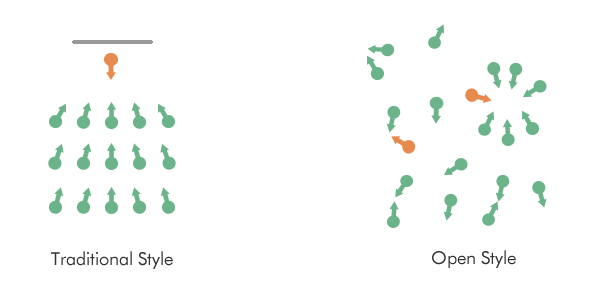
Second Design Principle: No Course Barriers – Introduction of Project Based Learning
In university lectures, it is usually thought best to teach a systematically starting with what is usually called “the basics”. While this style of teaching has a long history and is comfortable for some teachers and learners, it also makes many students disengaged because it is difficult to relate their learning with their lives. Furthermore, in this systematic style, students have difficulties connecting their school activities with their future work and lives. Social value or intrinsic pleasure from the act of learning itself is lacking. Earning credits or the grade itself becomes the main goal. Project Based Learning is very different from this systematic style which is exemplified in ordinary lectures which present knowledge set in every field. The Project Learning Approach takes away the barriers among subjects. Most human activities, in society or at work are not limited to one subject or another, but cross into many disciplines. In the same way the project based approach is a way of gaining a comprehensive experience in meaningful human activity. Educational research indicates that people learn more through significant social and personal activities. Furthermore, learners can apply how they learn to new situations which arise in their life, since PBL encourages design skills, research skills, experimentation, simulation and modeling practice and creative problem solving – what they learn Students collect information, carry on experiment, making a model, do a simulation, create an ideas to solve assignments given to project they take part in. Students are not limited to one discipline, but can learn in a more realistic, interdisciplinary style. The focus on grades is replaced by a focus on meaningful learning.

Third Design Principle: No Personal Barriers – Cooperative Learning & Team Teaching
In creating our new university, we have focused on the concept of Cooperative Learning as one of our key design concepts. CL is a total shift of learning philosophy and style. People we are learning with become part of our community, there to support us, challenge us to move to new depths of understanding, thus affecting both how we learn and what we learn. It is generally accepted that cooperative social and work environments are healthier and more productive, but this concept has not become a part of most university designs. FUN@Hakodate will be a learning community in which all aspects of the university, from physical structure through the open relationships among learners, including teachers, will promote learning cooperatively. If we look at learning outside of most formal classroom situations, it is apparent that it is both cooperative and social, as well as being supportive of individual expression and growth. Learning stagnates if there is no feedback loop; we need the opportunity to hear our own thoughts and see them reflected from others, particularly in a critically constructive environment. Moving away from the metaphor of pouring established information into the minds of students to a more constructionist and collaborative model, FUN@Hakodate is designing itself as learning community where problems can be solved together through a commonly developed set of shared meanings. These understanding will never be seen as dogma, but through the open exchange with others both locally and universally will constantly be challenged, re-examined and refined or re-built. In order to create this kind of atmosphere, we need to remove the kinds of situations which encourage learners to focus on individual performance on tests, and rather design spaces which encourage cooperative interaction – research, rethinking, presentation through various media. This does not mean that students will lose their identity in group work, but instead will find and develop their own strengths and unique talents, still thinking how they can work together with others, rather than working against others as in most competitive situations. Furthermore, by encouraging teachers with different perspectives and fields of research to take part in projects together, the idea that diversity is valued and that students should constantly be stretching themselves to think both widely and deeply. Through team teaching, the content of project becomes enriched, and students’ work can be evaluated from many different aspects.
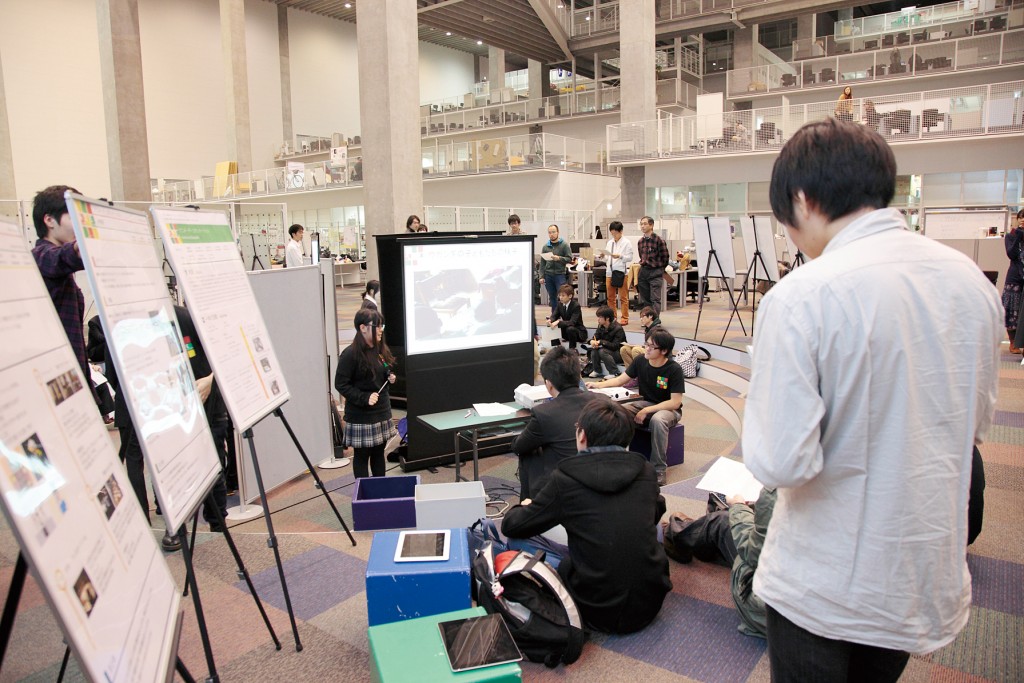
Fourth Design Principle: No Language or Communication Barriers- Acquisition of Communication Skills
Communication ability – the ability to listen to others and express ourselves – is very important for self-development and self-realization. At FUN@Hakodate, our theories of communication will grow out of our own lively, engaging, and authentic practice. So-called expert theories will not be handed meaninglessly to students to memorize, but rather our theories will develop through reflection of learners’ own work, as well as an understanding of the theories of others. In keeping with our concept of barrier-free learning spaces, communication, including the use of English and all sorts of media, is not something only taught in special classes held at particular times a week; it is an integral part of university life, with every subject stressing both the science and practice of communication along with the communication and practice of science. Both research and presentation are part of heart of learning. One of the important aims of FUN@Hakodate is to help learners see the value of research and presentation in their personal and professional lives, and to begin to develop their confidence as communicators in a wide range of situations, utilizing a wide range of media. Working in schools, homes for the aged or handicapped, on newspapers/radio/tv, and even street performances are ways we will enter into dialogue about the arts, science and technology with the local community. Furthermore, this dialog will be expanded beyond our local community of learners to the universe of learners though the internet and a-v conferencing, bi-lingual journals and tv shows as well as summer or year long exchange programs. With this design, foreign language skills will not be imposed but developed from the felt needs of the students. The contents of Project Based Activities will include presentation and exhibition design, technique of media use, theories of human cognition and communication, cooperative problem solving, and project design itself. A wide range of final outcomes will be honored – such as a traveling performance with acts demonstrating particular scientific principals that might be given to children, an interactive scientific exhibition in our university museum, a journal or tv show aimed at audiences around the world. In this way students’ ability to communicate scientific ideas in real world situations will be developed, a very different situation from the traditional university structure where knowledge is presented in rather limited ways only to a teacher.
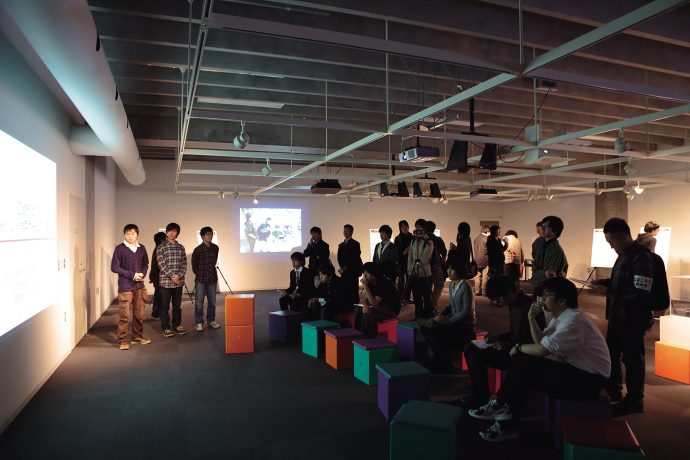
Fifth Design Principle: No Age or Learning Style Barriers – Diversity of Learners
One of the barriers in traditional universities is that only teacher and students in one location are taking part in the learning activities. We are planning to remove this partition in project work culminating in authentic communication activities. In this way, learners of all ages and cultures will interact. Some examples of such projects would be designing facilities for lifelong education like library or aquarium in a town, or creating toys for disabled children’s use, or planning ways that a local bookstore could develop to meet the needs of our university. If our students themselves are valued as knowers-in-progress, they will also begin to value others in the same way. Interacting with learners of all ages to understand their intuitive and developed theories of science will be most rewarding – from children in kindergarten through high school, to retired people and other adult learners, perhaps experts in a particular field, perhaps changing jobs. Bringing such people into our university life will change the way all members of community begin to see themselves as taking part in the life-long process of learning. Furthermore, we are greatly aware of the lack of women in the sciences and have taken it on ourselves to change this situation. Although the number of women students in science majors in Japan is increasing, it is still very low, so Future University at Hakodate will search for ways to encourage young women scientists to join us at every possible turn, and our goal is to accept half men and half women as students. By taking part in a respectful dialog with a diversity of learners, we will begin to see a wide range of styles and intelligences. Different study styles, learning styles, presentation styles; different kinds of intelligences – for problem solving, for thinking creatively, for social interaction, for artistic or dramatic expression – each person will feel his/her own power both individually and as a part of the learning community of FUN@Hakodate. We have even created a special museum space in our university where learners of all ages, from all sectors of society, with all styles of learning, can interact and share their visions.
Students as the Center of Learning
In traditional school education, “passing” knowledge through using standard textbooks and then evaluating solely based on what knowledge has been memorized is the standard approach. This style created the mistaken view that meaningful study activity is closed, individual work inside the university. It is different from what experts do in real society. Scientists’ activities include searching for meaningful issues, generating hypotheses, and finding ways to verify them. In contrast with this, education today focuses on memorizing propositions and formulas, or on proving an issue already known. Classes tend toward a drill and practice mentality so that so-called “basic knowledge” will be deeply instilled.
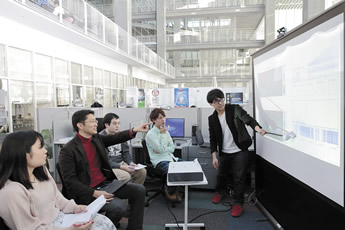
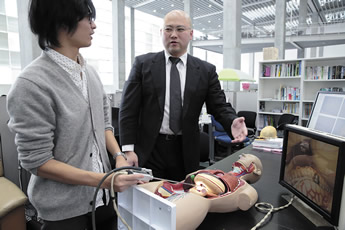
Students as Apprentice Researchers
Objectifying knowledge in this way removes all the mystery, surprise and relevancy of learning. It encourages passive learning and disengaged learners. In order to change the situation, at FUN Hakodate we regard our students as “apprentice researchers”. This means that they will take an active and vital role in research and will be seen and learn to see themselves as “theory-makers”, rather than as simply “theory-takers.” They will learn from their own mistakes and develop new attitudes about the value of mistakes. Faculty staff as a “senior researchers” have to show what they do consciously, thinking outloud as they work and provide opportunity for students to join them in authentic activities. In this way, students can begin to see learning as exciting, challenging and meaningful and themselves as active learners. This development of their own strong identity, in a world where young people’s individuality is often submerged by the deluge of images from new media and high-tech, we hope they can find new and joyful meaning in living. By giving students a change to be do “real” art, real science, real communication, we want them to become engaged in the joyful aspects of meaning-making and finding a place for themselves in today’s and tomorrow’s world.
Portfolio as Achievement
In university education at present, students can have their ability evaluated mostly through their performance on tests. But we believe that meaningful education is beyond simplistic evaluation which focuses on a single moment of a learner’s life. Future University Hakodate will encourage our students to develop awareness of how their behavior affects our environment and society. We value their process of social and intellectual growth, because we see learning as a process, rather than something that can be evaluated at a particular moment. Evaluation within a total context of the students’ learning is as important as learning in the total context of their lives. What a student doesn’t know but is in the process of learning, is much more important to us than what the student can demonstrate s/he already knows. This attitude totally changes the way learning is seen. Students immediately recognize the hypocrisy of saying “Learn in Context of your lives!” but then evaluating based on single event performance. We want to avoid such hypocritical actions – trust and respect among learners is vital to everyone’s growth! Thus our evaluation system will not aim to grade “objectively” or “relatively”, but will focus on development through feedback. Students will create their own portfolio of learning experiences over four years. Their portfolio will demonstrate a process of learning, what kind of technical knowledge or cultural theories they are developing, or what kind of projects they have been engaged in. This portfolio is accumulated from the time of entering our university and will be used as a record of their growth as learners. Their graduation thesis will represent a culmination of their work with us and become part of their portfolio, which can then be used to show their progress in learning, rather than a simple curriculum vitae when they are looking for work or planning to attend graduate school.
Prospect for the Future – Our University as a Learning Community
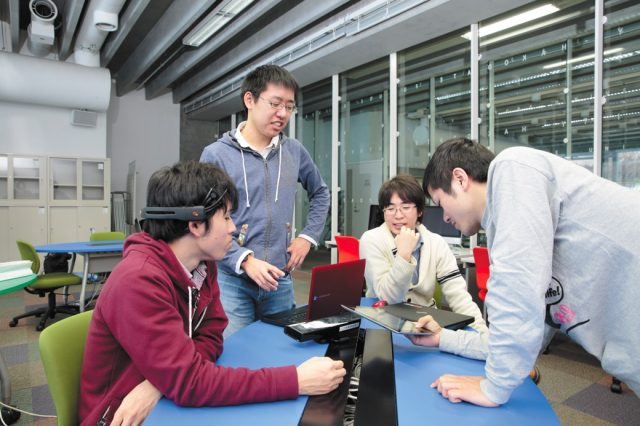 Providing the learning surroundings described above, the Future University at Hakodate intends to redefine “community” to include our students, our faculty and administrative staff, people in Hakodate and neighboring towns, people in the region of Hokkaido, and expanding throughout Japan and the world, offering learning opportunity to everyone within physical or digital reach. We want to redefine humans as lifelong learners through our sharing of meaningful learning and living experiences.
Providing the learning surroundings described above, the Future University at Hakodate intends to redefine “community” to include our students, our faculty and administrative staff, people in Hakodate and neighboring towns, people in the region of Hokkaido, and expanding throughout Japan and the world, offering learning opportunity to everyone within physical or digital reach. We want to redefine humans as lifelong learners through our sharing of meaningful learning and living experiences.
